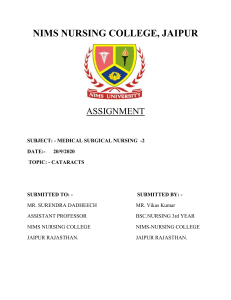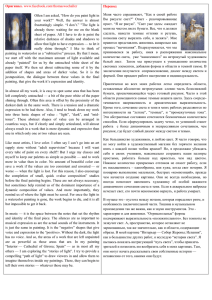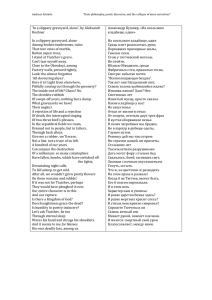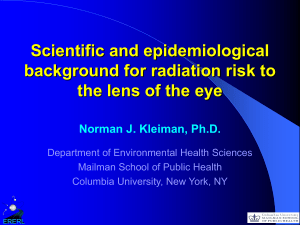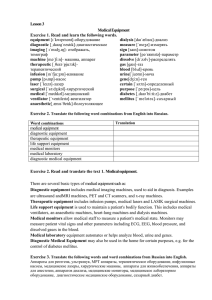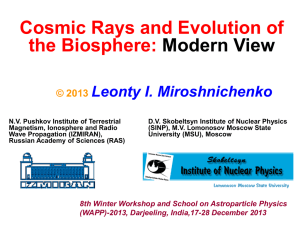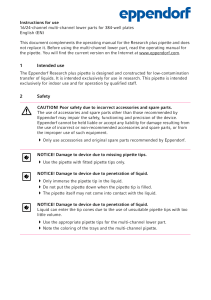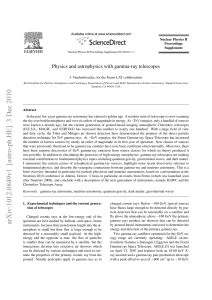anatomy organs of vision
реклама
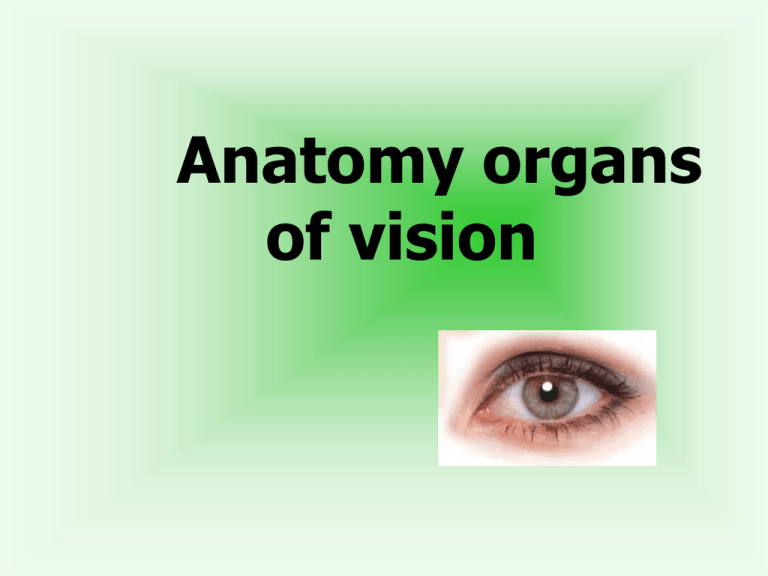
Anatomy organs of vision TABLE OF CONTENTS Introduction Main 1. Summary of the eye 2. The structure of the eye 4. Diseases of the Eye 4.1 Myopia 4.2 Farsightedness 4.3 Color Blindness 5. The human eye (Table) conclusion Introduction Ophthalmology - the science that studies the anatomy, physiology of the body, diseases related to the organs of vision, as well as the structure of blindness. Objectives of Ophthalmology - the maximum reduction in the number of blind and visually impaired. According to WHO, in the world there are 42 million blind and visually impaired. And every year there is an increase of this index, and represents an increase of 3-6% per year. I chose the theme of "Anatomy of the vision" because this issue is very relevant today, as a large number of people, especially school children now suffer from various eye diseases caused by visual overload, namely emission computer, TV, reading and load a letter to the school, and of course, not adherence to the simple rules to preserve the health of your eyes. A summary of the eyes The perception of visual stimuli: Light enters the eyeball through the pupil. Lens and vitreous body and serve for focusing the light rays onto the retina. Oculomotor muscles - six of them - ensures that the eyeball to the image of the object would fall exactly on the retina, the macula at her. In the receptors of the retina converts light into nerve impulses that are sent along the optic nerve to the brain - the visual area of the cerebral cortex. Begins in the retina analysis of color, shape, light object, its parts end up in the visual cortex. There is going to all the information, it is decrypted and generalized. As a result, develops understanding of the subject. Anatomy organs of vision A - auxiliary apparatus, eye muscles Б - diagram of the structure of the visual analyzer В - the structure of the retina Г - Diagram of the eyeball Д - eye color discrimination receptors The structure of eyedall 1 - cornea 2 - iris 3 - albuginea (sclera) 4 - choroid 5 - pigment layer 6 - yellow spot 7 - the optic nerve 8 - retina 9 - Muscle 10- ligament of the lens 11 - lens 12 - pupil In the retina, located receptors: rods (receptors twilight) and cones (they have a lower sensitivity, but can respond to color). Most of the cones located on the retina in front of the pupil, in the macula. Near this spot is a place of exit optic nerve, there are no receptors therefore it is called the blind spot. The structure of the auxiliary apparatus The muscles that move the eyeball Path of the rays in the clinical eye refraction - myopia Figure 1. Focus the image myopic eyes Figure 2 Nearsightedness (myopia) Path of the rays in the clinical eye refraction - hyperopia Figure 1. Focus the image farsighted eye Figure 2 arsightedness (hyperopia) What do you see? The structure of eye Eye - the organ of vision - can be compared with a window into the world. Approximately 70% of all information we receive through vision, such as the shape, dimensions, color of objects, the distance to them and others. Visual Analyzer monitors the motor and career rights; thanks to the vision we can learn from books the experience of mankind. The main purpose of the eye, or rather the visual analyzer - a vision of objects of the environment and the possibility of orientation in it - provides many support functions. Among them accommodative forming clarity subjects perceived environment on the retina, is one of the leading. Each of these functions, including accommodative realized their anatomical structures, collectively representing the structure of the eyeball. The organ of vision consists of the eyeball and the auxiliary unit. Auxiliary device - is eyebrows, eyelids and eyelashes, lacremal iron, lacrimal ducts, oculomotor muscles, nerves and blood vessels. Eyebrows and eyelashes protect the eyes from dust. In addition, eyebrows divert flowing sweat from his brow. Everyone knows that a person is constantly blinking (2 - 5 centuries of movements in 1 min). But what do they know? It turns out that the surface of the eye when blinking wetted tear fluid, which protects it from drying out, while at the same time free of dust. Slёznuyu liquid produce lacrimal gland. It contains 99% water and 1% salt. At night stands 1 g tear fluid, it's going in the inner corner of the eye, and then gets into the tear ducts that put her into the nasal cavity. If a person cries, slёznaya fluid does not have time to leave the tubules in the nasal cavity. Then the tears flow through the lower eyelid and trickling down our face. Глазное яблоко располагается в углублении черепа – глазнице. Оно имеет шаровидную форму и состоит из внутреннего ядра, покрытого тремя оболочками: наружной – фиброзной, средней – сосудистой и внутренней – сетчатой. Фиброзная оболочка подразделяется на заднюю непрозрачную часть – белочную оболочку, или склеру, и переднюю прозрачную роговицу. Роговица представляет собой выпукло-вогнутую линзу, через которую свет проникает внутрь глаза. Сосудистая оболочка расположена под склерой. Её передняя часть называется радужкой, в ней содержится пигмент, определяющий цвет глаз. В центре радужной оболочки находится небольшое отверстие – зрачок, который рефлекторно с помощью мышц может расширяться или сужаться, пропуская в глаз необходимое количество света. Собственно сосудистая оболочка пронизана густой сетью кровеносных сосудов, питающих глазное яблоко. Изнутри к сосудистой оболочке прилежит слой пигментных клеток, поглощающих свет, поэтому внутри глазного яблока свет не рассеивается. Непосредственно за зрачком находится двояковыпуклый прозрачный хрусталик. Он может рефлекторно менять свою кривизну, обеспечивая четкое изображение на сетчатке – внутренней оболочке глаза. Nearsightedness (myopia) Nearsightedness (myopia) - mostly due to hereditary disease, when in a period of intense visual load, due to the weakness of the ciliary muscle, circulatory disorders of the eye occurs stretch dense covering of the eyeball (the sclera) in the anteroposterior direction. Eyes instead takes the form of spherical ellipsoid. Because of this extension of the longitudinal axis of the eye images of objects focuses not on the retina, but in front of it, and the person tends to bring everything to the eyes, use glasses with scattering ("minus") lenses to reduce the refractive power of the lens. Myopia unpleasant fact that the progression of the disease occur in dystrophic lesions of the eye leading to irreversible loss of vision not corrected by glasses vision loss. To avoid this, it is necessary to combine the experience and knowledge of an ophthalmologist with perseverance and the will of the patient in the sustainable distribution of visual load, periodic self-monitoring of the state of their visual function. Farsightedness (hyperopia) Farsightedness (hyperopia) - is a congenital condition, especially the structure of the eyeball: it is a short eye or eyes with poor optics. Rays while going behind the retina. To this eye could see in front of him to place the collecting ("plus") lenses. This condition may be long "hiding" and appear in 20-30 years and later in life; it all depends on the eye of reserves and the degree of farsightedness. Age farsightedness (presbyopia). With age, the power of accommodation decreases gradually, by reducing the elasticity of the lens and the ciliary muscle. State occurs when the muscle is no longer able to minimize and lens, losing elasticity, can not accept the maximum spherical shape - as a result of the eye loses the ability to distinguish small, closely spaced objects to it, and the person tends to push them away from the eyes (to facilitate the work of ciliary muscles). For the correction of hyperopia are assigned points for proximity to the collecting ("plus") lenses. The correct mode of visual work and systematic training of view will significantly push the timing of the farsightedness for many years. Color blindness Color blindness - the inability to correctly identify certain colors. ? It may be hereditary nature or be caused by disease of the optic nerve or retina. The test for color blindness Acquired color blindness occurs only on the eye, which struck the retina or optic nerve. His is the progressive deterioration over time and the difficulty in distinguishing between blue and yellow. Hereditary blindness is more common, affects both eyes and does not deteriorate with time. This embodiment of color blindness in varying degrees of severity is present in 8% of men and 0.4% of women. Hereditary blindness associated with the Xchromosome and almost always passed from mother carrying the gene to her son. The human eye Systems And appendages of the eye Structure Functions Auxiliary Eyebrows Hair growing from the inner to the outer corner of the eye withdrawn sweat Eyelids Skin folds with eyelashes Protect your eyes from the light rays, dust lacrimal apparatus Lacrimal gland and the tears which eliminates liquidт Tears moisten, cleanse, disinfect eye tunica The dense outer shell consists of connective tissue Protective vascular Average shell permeated with blood vessels Power eyes retina The inner shell consists of photoreceptors: rods and cones perception of light shell Optical Cornea The transparent front part of the tunica albuginea Refracts light rays Aqueous humor Clear liquid, located behind the cornea Skips the rays of light iris The front part of the choroid Contains a pigment that gives color eye pupil The hole in the iris muscle surrounded Regulates the amount of light crystalline lens Lenticular, elastic, clear lens, surrounded by the ciliary muscle refracts and focus the rays light has accommodation vitreous body clear gelatinous body fills the eye apple, misses light rays perceive light photoreceptors In the retina, in the form of rods and cones (about 125 million. Rods and 6 million. Cones, the main mass cones concentrated in the central area of the retina - in the macula; as distance from the center number of cones decreases and rods increases. On the periphery of the retina are only coli) sticks takes the form of (vision in low light), cones - color visual nerve The nerve cells of the cortex, from which starting fiber optic, connected to processes of photoreceptor neurons Perceives excitation is transmitted to the visual area cerebral cortex, where the excitation and analysis occurs forming visual images Conclusion Eye - a complex physiological system photooptically, the ability to perceive the impact of the environment in the form of radiant energy. I also found some simple rules you need to follow to keep your vision for years to come and how to eat, as the food and the overall health of the body plays an important role in maintaining eye health. I learned how to time and as soon as possible to recognize the various disorders of the functioning of the body, how to protect their eyes from overload and prevent the development of diseases of the eye, independently regularly monitor the status of their visual function. I learned more about the structure and functioning of our body of diseases such as nearsightedness, farsightedness, astigmatism, cataracts, glaucoma and other, their prevention and treatment. Because it is often the person who receives enough information about this or other eye diseases, disorders functioning of the visual organ can bring everything to the extreme, that perhaps you can still fix at best, and at worst, all of which can lead to complete loss of vision - blindness . Treat your eyes gently and carefully !!!

